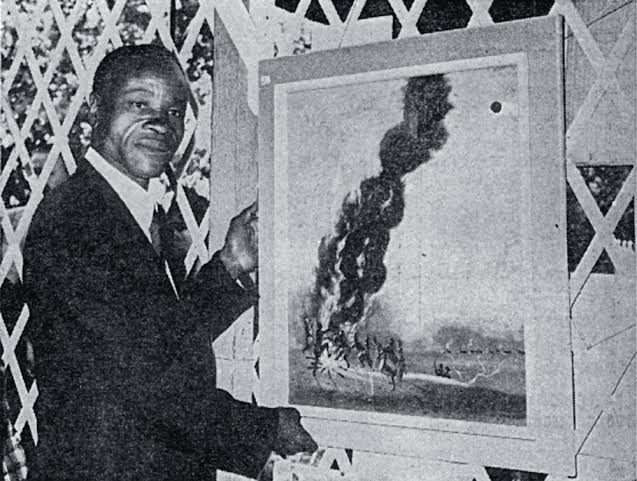Remembering one of the founding fathers of the Modern South African Visual Arts, John Koenakeefe Mohl
On Tuesday I had another sit down session, with Mme Helen Mmakgabo Mmapula Mmankgato Sebidi, which you'd be forgiven to term it 'Afternoon Tea with Mme Mpule'. I learn so much from these kind of sessions. The focus today is not on Mamogolo Helen but on one of her teachers and mentors John Koenakeefe Mohl. Mohl was born in 1903 in Zeerust in the North Western province of South Africa and died in 1985 in Soweto.
John Koenakeefe Mohl, pic from internet.
John Koenakeefe 'Mohl' Monnyane (little one) and later written Mohlangkana (Young man) , popularly known as Mohl was born in 1903 in Zeerust in the North Western province of South Africa. His last name was changed to the palatability of the European tongues as they always claim that African names are difficult to pronounce.
John Koenakeefe Mohl was a Pioneering spirit in making a mark for the black modern visual art in South Africa and his name and contributions are often omitted, erased and deliberately not celebrated. Helen Sebidi related to me a story where the local art publication in the 70s or 80s did not want to include his name. One occasion was an interview she gave on her art where she had mentioned Mohl is someone who encouraged her to pursue art as a career but the following day when the article appeared, his name was omitted with a white person's name.
He attended Tigerskloof Training School where he attained a teacher’s diploma and subsequently left for Namibia to work on the docks at Lüderitz in order to study art with a French woman artist, Mary du Pont. He went to Germany to further his studies at Düsseldorf Art Academy in the early 1930s before returning to Cape Town in 1936. Upon his arrival he painted Kgosi Tshekedi Khama’s portrait, which was shown on the Empire Exhibition. In 1943 he won an Academy award for painting.
Mohl established an art school which is arguably one of the first art school for black people, called The White Studio, in the backyard of his home in Annadale Street, Sophiatown in 1944. It is crucial to point out that the driving of this establishment was to encourage the art profession in the black community, what could have been termed 'Bantu Community' then. Explaining his objectives in 1944 to the Bantu World publication, Mohl emphasized: ‘Our efforts in this studio aim at encouraging African talent through bringing within reach of promising pupils a good training in painting’ because: ‘A very high percentage of our talent lies buried. It is for Africans themselves to unearth it, train it and enable it to make its full contribution to the culture of our country. What is more, African artists will be among the foremost interpreters of our people to the other races’ (20 May 1944).
In 1948 he was commissioned by the then Bechuanaland government to paint places of historic importance in the territory and between 1953 and 1954 he painted Moeng College and King Khama’s Memorial Stone for Kgosi Tshekedi Khama. Mohl was a founder member of Artists under the Sun in 1960 and he served on the committee of this organization until his death. After the demolition of Sophiatown, Mohl moved to Soweto where he eventually settled in Moroka in the mid-1970s and held exhibitions of his paintings in his garden.
Mohl played a significant role in the development of many artists in this country including Helen Mmakgabo Mmapula Mmankgato Sebidi. When interviewed by Khanya Mashabela in 2018 she said "I studied with Mr [John] Mohl, and I did ask him: “Why am I like this, and you’re like that?” and he said, “No. That’s your style.” As I went on, he approached me to say, “You are gifted and you have a calling from those people you are drawing and painting, the people from behind. It’s not your grandmother who is calling you. There is a calling from your ancestors. While you are looking after your grandmother, you need to do your research. It is those people who wore skins, who are inviting you to come. Go and do the research. That’s where you are wanted, I am finished with you.” That’s how I went, very happily, after he had guided me on how to ask them questions, deep down. And he told me, “I don’t want to see ‘Johannesburg’ work or any ‘Soweto’ work, you must bring yourself to those people.”
Mohl was a founder member of Artists under the Sun in 1960 and he served on the committee of this organization until his death. After the demolition of Sophiatown, Mohl moved to Soweto where he eventually settled in Moroka in the mid-1970s and held exhibitions of his paintings in his garden. He played a leading role in the affairs of the St Francis Anglican Church which was close to his home in Moroka and also painted a panel of the Crucifixion for the church. He also gave art lessons at the Madibane and Orlando High Schools in Soweto. In 1972 Mohl founded the Moroka Sympathising Friends Scheme which he also chaired. Lybro Nyelele, Credo Mutwa, Helen Sebidi and his wife Puseletso Mohl also studied art with him.
Sources
http://revisions.co.za/biographies/john-koenakeefe-mohl/#.YFrwbhi6I0O
https://artthrob.co.za/2018/11/16/seeing-gifts-and-stolen-people-in-conversation-with-mmakgabo-mapula-helen-sebidi/
https://www.sahistory.org.za/article/artist-groups-and-educational-facilities-1960-1980





Comments
Post a Comment